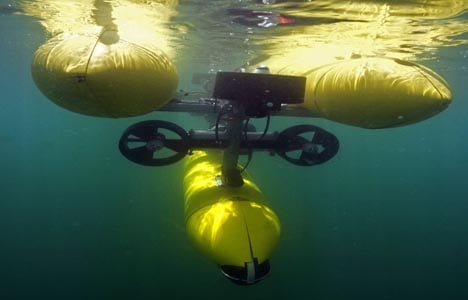Under the scrutiny of their masters, whose eyes are glued to computer screens, the world's first fleet of "marine drones" is being put through its paces.
Five European countries — France, Germany, Italy, Spain and Portugal — have sent prototypes here under a four-year, four-million-euro ($5.32-million) programme to build a squad of unmanned underwater rovers.
Deployed from a surface vessel, but communicating among themselves and using artificial intelligence, the wireless scouts would spread out in a surveillance network.
Using video cameras and echosounders, the explorers would help to create 3D maps of underwater terrain, benefiting oceanographers, archaeologists,offshore oil and gas drillers, pollution monitors, marine biologists and other civilian users.
But there is an obvious naval use too, for a flexible network of small, hard-to-detect drones would multiply the surveillance capacity against mines and other threats.
"Underwater robots are not new — we've been involved in them for years," said Vincent Rigaud, director of underwater systems at the French Institute for Research for Exploitation of the Sea (Ifremer), one of the world's top names in oceanography.
"What is new, though, is creating a fleet of them, with autonomous capacity."
Achieving this means overcoming two major hurdles, Rigaud explained.
One is software: creating artificial intelligence programmes that give the options for cooperating in a group and coping with the uncertainties of the marine environment, with its tides and currents.
The other is communications. Airborne drones can talk to each other, and to their controller, by the instant means of radio.
But radio waves do not penetrate underwater, which leaves sound the only option for communication among the marine drones.
Rather like a school of dolphins chirping to each other, the robots use acoustic signals to swap information and instructions — and as experiments have shown, this is not an easy thing.
The communication is frustratingly long because the data flow is so slow, and the tenuous sound link is easily disrupted by other sources of noise, such as a passing vessel.
"It's like going back to modems in the dawn of the computer age," said Pere Ridao of the University of Girona in Spain.
"The maximum flow rate is about 100,000 times slower than a typical ADSL connection. It takes several minutes to send a picture."
On a mission, the robots would share a rough map of the underwater terrain, showing major obstacles to avoid, but would then work by themselves within designated parameters.
What they see and monitor would be stored in onboard memories which would then be downloaded after they are recovered. Powerful computers would crunch the raw data into usable applications.
"The vehicles are not physically connected but virtually connected," explained Antonio Pascoal, a professor at Portugal's Superior Technical Institute (IST).
"The idea is for them to dialogue and adapt to marine geometry without human intervention."
The programme, called MORPH (Marine Robotic System of Self-Organising, Logically Linked Physical Nodes), was launched in February 2012 with the help of the European Commission. Thirty-two scientists are taking part.
Things are still at an early stage, with up to five machines learning how to move in formation in shallow water.
The models generally favour either a torpedo or a "sledge" design, reflecting at this conceptual stage the different notions for dealing with mission requirements.
Italy, for instance, has a 31-kilo (66-pound) torpedo-shaped tiddler, designed by the NATO Undersea Research Centre (NURC) in La Spezia, which can
operate for eight hours in depths of up to 80 metres (260 feet).
Spain's 200-kilo (440-pound) Girona 500 comprises three rounded tubes driven by twin propellers, able to operate at depths of up to 500 metres (1,625 feet), also for eight hours, according to the MORPH website



 Please whitelist us to continue reading.
Please whitelist us to continue reading.
Member comments